Google Pixel 9 release date, price, specs and all the new AI features
Here's the lowdown on Google's latest Pixel phone
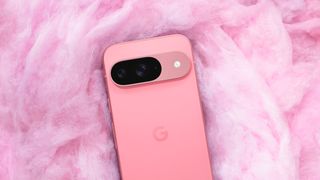
Made by Google is happening right now. Check out our live blog for the news as it breaks, and also check out our Google Pixel 9 hands-on review.
The Google Pixel 9 is finally here, bringing with it an all-new design that promises to be sleek, pocketable, offering one of Google’s best cameras to date and packs in an all who chipset that powers a bunch of new AI features. Unfortunately, the price has gone up and you’ll have to wait for Android 15.
Prices for the Pixel 9 start at $799, which is $100 more than you would have paid for a brand new Google Pixel 8. The phone will also come running Android 14 at launch, and we still don’t know when Android 15 will be officially released. Still you are getting a bunch of upgrades and features with the Pixel 9, including hardware to power newer and better AI features. Whether that’s worth the increased price of admission is entirely up to you.
Whether you’re interested in hardware or software, here’s everything you need to know about the Google Pixel 9. or be sure to check out our Google Pixel 9 hands-on review for our first impressions of the new phone.
Google Pixel 8 cheat sheet: The major changes
- The Pixel 9 is powered by the new Tensor G4 and a boosted 12GB of RAM. That’s designed to offer “powerhouse performance” and handle all the latest and best AI features without issue
- Google’s refreshed the design of the Pixel 9 this year, reducing the size of the camera bar and adding rounded corners to the device.
- The screen is brighter than ever with the 6.3-inch Actua display now offering up to 1,800 nits of HDR brightness and a maximum of 2,700 nits.
- Durability will enjoy a boost, with Gorilla Glass Victus 2 on the front and back of the phone. The phone also offers the same IP68 water and dust resistance rating as the Pixel 8.
- The ultrawide camera lens has been upgraded to 48MP, and while there’s still a 10.5MP selfie camera it’s added autofocus to a non-Pro Pixel for the first time
- Battery capacity has been boosted to 4,700 mAh, with Google promising a 24 hour battery life. Wired charging speed is still limited to 27W, but it promises to restore 55% battery in 30 minutes.
Google Pixel 9 pricing and availability
The Google Pixel 9 starts at $799 / £799 for a model with 128GB of storage, which is $100/£100 more than the equivalent Pixel 8 would have cost you last year. A 256GB model is also available, and costs $899 / £899
Color options include Obsidian, Porcelain, Wintergreen and Peony. Which are fancy ways of saying black, white, mint green and pink.
Pre-orders for the Pixel 9 open on August 13, with the phone currently scheduled for release on August 22 alongside Pixel 9 Pro XL.
Sign up to get the BEST of Tom's Guide direct to your inbox.
Get instant access to breaking news, the hottest reviews, great deals and helpful tips.
Google Pixel 9 Specs
| Google Pixel 9 | Google Pixel 8 | |
|---|---|---|
| Display | 6.3-inch (1080 x 2424) Actua OLED | 6.2-inch (1080 x 2400) Actua OLED |
| Refresh rate | 60-120Hz | 60-120Hz |
| Chipset | Tensor G4 | Tensor G3 |
| RAM | 12GB | 8GB |
| Storage | 128GB/256GB | 128GB/256GB |
| Rear cameras | 50MP main (f/1.68) with 8x Super Res Zoom, 48MP ultrawide (f/1.7) | 50MP main (f/1.68) with 8x Super Res Zoom, 12MP ultrawide (f/2.2) |
| Selfie camera | 10.5MP (f/2.2) | 10.5MP (f/2.2) |
| Battery | 4,700 mAh | 4,575 mAh |
| Dimensions | 6 x 2.8 x 0.3 inches | 5.9 x 2.8 x 0.4 inches |
| Weight | 7 oz (198 grams) | 6.6 oz (187 grams) |
| IP Rating | IP68 | IP68 |
| Price | From $799 | From $699 |
Google Pixel 9: What's New
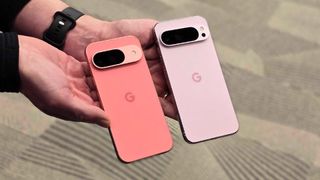
The Pixel 9 has had some noticeable design changes compared to the Pixel 8, with a more rounded design that should prove to be noticeably more comfortable in the hand. The camera bar has also been reduced slightly, now taking the form of a rounded module on the back of the phone. The screen is also slightly bigger, measuring 6.3 inches instead of 6.2, while the phone itself is 0.05 inches thinner. But, with a weight of 7oz, it is 0.4 oz heavier than last year.
The big change to that display is the brighter version of Google’s Actua display, which now offers 1,800 nits of HDR brightness and a peak brightness of 2,700. The Pixel 8 topped out at 2,000 nits, with 1,400 nits of HDR brightness, and means the new model should perform even better in all kinds of lighting conditions. Both the front display and back glass are made of Gorilla Glass Victus 2, which should provide better strength compared to Pixel 8’s Victus 1 glass.
Google has also boosted the size of the battery to 4,700 mAh, once again promising that this battery can last over 24 hours. This can apparently be extended up to 100 hours with Extreme Battery Saver switched on, up from 72 hours last year. Sadly wired charging is still limited to 27W, which means you don’t need to pick up the new 45W charging brick. Wireless charging has actually dropped from 18W to 15W with a Pixel Stand 2, or 12W with a standard Qi charger.
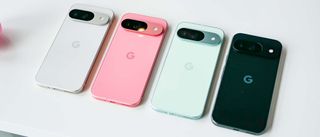
Of course, it wouldn’t be a new Pixel flagship without a brand new Tensor chipset, and this year the Pixel 9 comes packing the Tensor G4 plus a whopping 12GB of RAM — 4GB more than the Pixel 8. Google says the G4 has been optimized for Google AI, and specifically Gemini Nano, to offer the “most capable on-device AI”
The goal here is to ensure that the phone has access to all the latest and best AI features and without necessarily offloading everything to the cloud. The Pixel 8 struggled with that, and it looks like Google’s taken steps to ensure the Pixel 9 doesn’t have the same issues.
AI ties into the camera too, with a bunch of AI features that will help improve your shots. Hardware has had some attention too, with Google upgrading the Pixel 8’s 12MP ultrawide camera to 48MP, offering some extra parity with the Pro models — minus the telephoto lens, of course. The 10.5MP selfie camera has also added autofocus, which Google says is a first for its non-Pro Pixel phones.
Finally there’s the Satellite SOS feature for Pixel users in the U.S., with an international rollout expected at an unspecified point in the future. The Pixel 9 will be able to connect to satellites to make emergency calls when you don’t have any cell signal. This is free for Pixel users for the first two years, but you will be expected to pay afterward.
Google Pixel 9: AI features
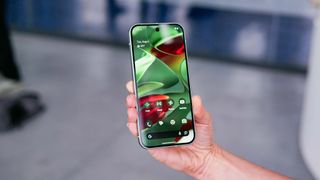
As you might expect, there are a bunch of AI features coming to the Pixel 9 — the most important of which is multimodal Gemini Nano. This on-device AI model lets you access AI features without offloading anything to the internet, meaning you don't even need a data or Wi-Fi connection to get things working.
The multimodal part means you can actually interact with the Gemini AI in multiple ways, including images, audio, text and speech — whatever feels right for you.
The Pixel 9 will also feature the new Gemini Assistant, which infuses Google Assistant with AI capabilities. Then there's Gemini Live, which is available as part of a Gemini Advanced subscription, that lets you converse with the AI and get responses in real time.
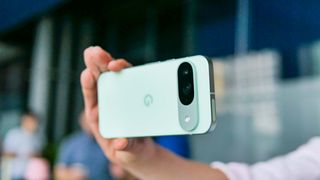
Naturally, there are camera and photo-editing AI tools involved, including "Add Me" which lets the photographer join in with a group photo. Simply hand your phone to someone else while AR guides you to the correct spot. From there, generative AI will add you to the original photo to make it look like you were always there.
Then there's Auto Frame, which crops or expands images to improve their look, while ReImagine lets you use written prompts to generate brand new backgrounds for existing photos. If you'd rather generate images from scratch, Pixel Studio is Google's image generation app that uses the Imagine 3 Diffusion Model to generate images based on your prompts.
Other AI features include Magic Lists which auto-populates lists in Google Keep, Call Notes for summarizing phone calls, and Pixel Screenshots which collects all your screenshots in a brand new app and automatically organizes them for you.
Google Pixel 9: How it compares to other phones
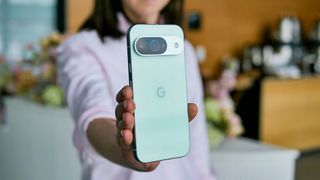
The Pixel 9’s main competition right now are the Galaxy S24 and iPhone 15, which are some of the best phones available right now. Not as good as their Pro and Ultra counterparts, but still offering a great phone experience without making you pay $1,000+ for it.
From a camera perspective, Google certainly has some kind of hardware advantage with the Pixel 9’s new 48MP ultrawide lens — offering much higher resolution than the 12MP offerings on the Galaxy S24 and iPhone 15. Likewise, the Galaxy S24 seems to have an advantage thanks to its 10MP 3x zooming telephoto lens, and all 3 should be on an even footing with their 50MP or 48MP main lenses.
Of course, cameras aren’t quite so simple, especially with the amount of software that’s required to bolster the system. All three companies have their own telephoto-quality digital zoom, and Google pushes that further on Pixel 8 with 8x SuperResZoom. So it’s impossible to say which phone will produce better cameras until we actually get to test the Pixel 9 for ourselves.
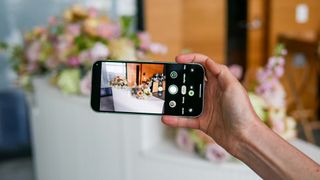
The same goes for battery life. The Pixel 9 may have the largest battery pack with 4,700 mAh, compared to Samsung’s 4,000 mAh and iPhone 15’s 3,349 mAh, but there’s no guarantee that it’ll last longer. In fact, experience tells us that Google often fails in this area, particularly thanks to the Tensor line being much less efficient than flagship Snapdragon and Apple A-series chips.
The screen is where the Pixel 9 shines, though, with its 1,800 nits of HDR brightness and a peak brightness of 2,700 nits. That peak is 100 nits more than the Galaxy S24 and 700 nits higher than the iPhone 15, meaning this should be the phone you want in bright and otherwise awkward lighting conditions.
The big comparison is going to be with AI, something Google and Samsung have been working on for some time — though Google did get a big head start. Meanwhile, Apple Intelligence is still officially in beta and likely won’t be released to the public until after the iPhone 16 launch in September. Then again without Android 15, there’s no telling how long it might take for the Pixel 9 to get all the features Google has announced so far. So we’ll just have to wait and see what happens on this front.
Google Pixel 9: Verdict
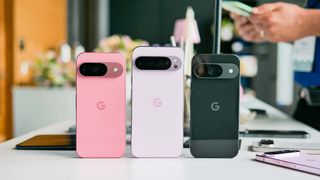
From a hardware perspective Google has done a great job with the Pixel 9. We’ve had all the usual upgrades, including a brand new camera lens, a super bright screen, a more durable kind of Gorilla Glass and even a larger battery that Google phones typically need to take full advantage of. There’s even a slight redesign which, while not groundbreaking, helps mix things up a bit compared to previous Pixel flagships. Still we’re still not very happy about the price going up for the second year in a row. Remember when Google used to be a cheaper alternative to the other major brands?
The hardware only tells us so much about what the Pixel 9 will be able to handle. While we expect the camera and AI features to be top notch, thanks to Google’s extensive experience with both, there’s no telling how the rest of the phone might perform. The Tensor is still a wildcard, and there’s no telling what sort of impact it might have on the phone — leading us with few ideas on what to expect.
The new AI features certainly seem like they could be a major boon to Google’s phone, though once again it’ll all depend on just how well they work. Thankfully Google hasn’t let us down in the past, and we should see the likes of Pixel Studio and Add Me perform become incredibly useful tools in your repertoire.
Based on our first impressions in our Google Pixel 9 hands-on review, things are looking good. But we won’t know for sure until we get our hands on the Pixel 9 and do some more thorough testing. Until then we can only speculate about how well the phone will actually perform.
More from Tom's Guide

Tom is the Tom's Guide's UK Phones Editor, tackling the latest smartphone news and vocally expressing his opinions about upcoming features or changes. It's long way from his days as editor of Gizmodo UK, when pretty much everything was on the table. He’s usually found trying to squeeze another giant Lego set onto the shelf, draining very large cups of coffee, or complaining about how terrible his Smart TV is.
